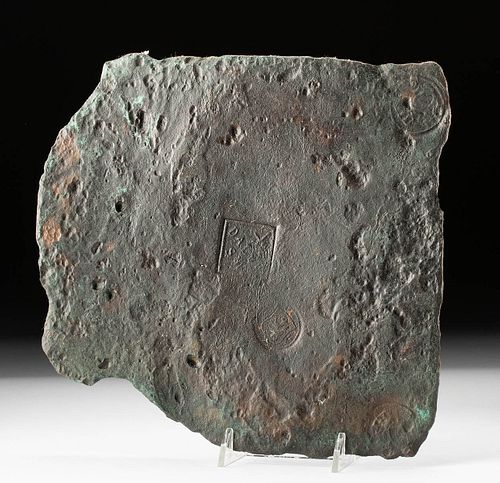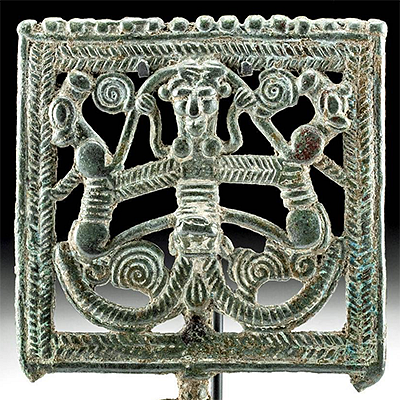Swedish Copper Platmynt 4 Daler, Nicobar Wreck ca. 1716
Lot 126
About Seller
Artemis Gallery
686 S Taylor Ave, Ste 106
Louisville, CO 80027
United States
Selling antiquities, ancient and ethnographic art online since 1993, Artemis Gallery specializes in Classical Antiquities (Egyptian, Greek, Roman, Near Eastern), Asian, Pre-Columbian, African / Tribal / Oceanographic art. Our extensive inventory includes pottery, stone, metal, wood, glass and textil...Read more
Categories
Estimate:
$800 - $1,200
Absentee vs Live bid
Two ways to bid:
- Leave a max absentee bid and the platform will bid on your behalf up to your maximum bid during the live auction.
- Bid live during the auction and your bids will be submitted real-time to the auctioneer.
Bid Increments
| Price | Bid Increment |
|---|---|
| $0 | $25 |
| $300 | $50 |
| $1,000 | $100 |
| $2,000 | $250 |
| $5,000 | $500 |
| $10,000 | $1,000 |
| $20,000 | $2,500 |
| $50,000 | $5,000 |
| $100,000 | $10,000 |
| $200,000 | $20,000 |
About Auction
By Artemis Gallery
Nov 5, 2020
Set Reminder
2020-11-05 10:00:00
2020-11-05 10:00:00
America/New_York
Bidsquare
Bidsquare : Ancient & Ethnographic From Around the World
https://www.bidsquare.com/auctions/artemis-gallery/ancient-ethnographic-from-around-the-world-5916
Ancient art from Egypt, Greece, Italy and the Near East, as well as Asian, Pre-Columbian, Native American, African / Tribal / Oceanic, Spanish Colonial, Russian Icons, Fine art, much more! All categories, all price ranges... all legally acquired and guaranteed to be as described or your money back. Artemis Gallery info@artemisgallery.com
Ancient art from Egypt, Greece, Italy and the Near East, as well as Asian, Pre-Columbian, Native American, African / Tribal / Oceanic, Spanish Colonial, Russian Icons, Fine art, much more! All categories, all price ranges... all legally acquired and guaranteed to be as described or your money back. Artemis Gallery info@artemisgallery.com
- Lot Description
Northern Europe, Sweden, ca. 1716 CE. Northern Europe, Sweden, ca. 1716 CE. A Swedish copper platymynt 4 Daler faintly stamped with King Charles' XII of Sweden royal crest on two corners; a crown with interlacing CC 17 XII 16. The denomination stamped in the center; 4 DALER S:M and a shield crest marked below. This plate was a form of currency in Sweden and plasmin dealer translates to "plate dollar." This 4 dealer of copper was worth a certain amount of silver, which is what "S:M" denotes. The verso is usually blank, but this plate has an indiscernible circular impression, perhaps a stamp for redenomination. Sweden created huge copper plates as currency due to a silver shortage. Unfortunately copper coin did not hold as much value as silver, resulting in these massive plates. Most plasmin's were melted down and repurposed over the years, making these original plates quite rare! See below on why this one survived intact. Size: 8.75" L x 9.5" W (22.2 cm x 24.1 cm); total weight: 1905.09
This 4 daler is heavy and the inconvenience of carrying these plates led to the creation pf paper bank notes that could be exchanged, and consequently the need and value of the copper plates fell and most were melted down. In the 1780's, Sweden began exporting these copper plates to trade with colony countries. In 1783, the Danish ship, Nicobar, was sailing to India with a cargo consisting of Swedish platmynts, but a storm wrecked the ship off the coast of South Africa. The wreck was discovered in 1987, and this plate was finally recovered after spending nearly two hundred years at the bottom of the ocean!
Provenance: ex- estate of Eldert Bontekoe, Pegasi Numismatics, Ann Arbor, Michigan, USA acquired before 2000
All items legal to buy/sell under U.S. Statute covering cultural patrimony Code 2600, CHAPTER 14, and are guaranteed to be as described or your money back.
A Certificate of Authenticity will accompany all winning bids.
We ship worldwide and handle all shipping in-house for your convenience.
#159404Only two corner stamps remain, they are faint and mostly illegible with softening of details. Half of the central stamp is boldly marked. Losses to peripheries as shown and surface pitting. Rich patina!Condition
- Shipping Info
-
All shipping is handled in-house for your convenience. Your invoice from Artemis Gallery will include shipping calculation instructions. If in doubt, please inquire BEFORE bidding for estimated shipping costs for individual items.
-
- Buyer's Premium



 EUR
EUR CAD
CAD AUD
AUD GBP
GBP MXN
MXN HKD
HKD CNY
CNY MYR
MYR SEK
SEK SGD
SGD CHF
CHF THB
THB














